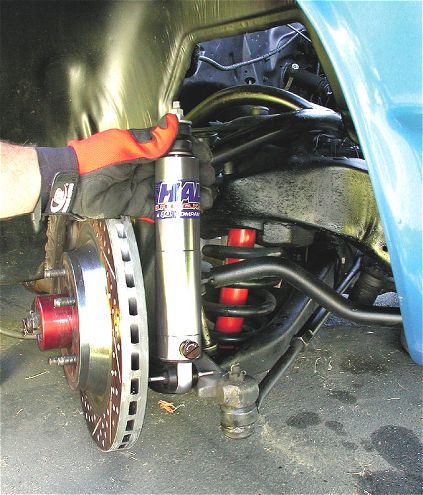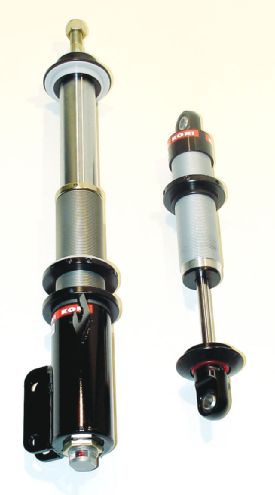
In car-crafting lore, there are anywhere from one to three sealed boxes in any performance machine. One is the torque converter, another is the computer that does its electronic thing, and the third is the universal unknown--the shock absorber. In fact, even its name is not technically correct. Absorbing the "shock" of bumps and suspension loading is actually performed by the springs in the suspension. Controlling the energy stored in the spring is the shock's real job, and everywhere else except in the U.S. it's called a spring damper.

Basics
Especially with an enigmatic thing like a shock absorber, we need to start with the basics. First, it's critical to emphasize that shocks do not support the weight of a vehicle, and they better not be propping up one or more corners of your car. If this is the case, you have serious problems. The exception to this is the air shock, which was popular about 30 years ago but was never a good idea. We also need to go over a couple of terms often used in discussing shock absorbers. As the shock is pushed together, this is called bump or compression. As the shock expands, this is called rebound. When the vehicle encounters a bump and compresses a spring, energy is stored in the spring. As the spring expands against the weight of the sprung mass of the vehicle, the shock absorber forces oil through various metered orifices in the shock valving to control this action.
Shock absorbers are basically hydraulic units that are inherently velocity sensitive. That means that as the suspension is compressed at a faster rate, the chassis needs a device that can apply progressively more force to dampen the additional spring energy as it expands in rebound. Nonadjustable shock absorbers are created with a certain bump and rebound rate as defined by the manufacturer to create a given suspension control and a comfortable ride all in one package. But when we get into high-performance automobiles, this compromise is usually less than ideal. This is especially important with specialized applications like drag racing or road-course racing that demand specific bump and rebound curves in order for the shock absorbers to work best.
 Struts are a combination of a suspension component and shock absorber. You'll find struts on the front suspension on cars like '79 to '93 Fox-body Mustangs and third-generation Camaros.
Struts are a combination of a suspension component and shock absorber. You'll find struts on the front suspension on cars like '79 to '93 Fox-body Mustangs and third-generation Camaros.
Characteristics
If you've ever driven a car with dead shocks, then you've lived the definition of "mushy". Without that application of dampening force, the springs will virtually never stop oscillating. This loss of control has been best described as four independent pogo sticks on the four corners of the car all bouncing at a different rate. As the spring oscillates, it also unloads the tires, and it doesn't take much of an imagination to see that if you cannot control the contact patch between the tires and the road, you have no chance of controlling the car in any type of dynamic situation.
Another important aspect of shock design is that they always offer more dampening control in rebound than in bump, since the shock needs this additional rebound force to control the spring as it expands. This relationship can and does change with each manufacturer's shocks and the specific tuning for a given vehicle. But since car crafters are always asking their cars to do different things, a given shock absorber valving might not be correct or even close for all different kinds of cars. This requirement spawned a huge market for adjustable shock absorbers that could be given a wide range of bump and rebound control.
Shock Design
Performance shock absorbers are offered in both single- and double-adjustable configurations. Double-adjustable shocks offer the ability to trim the bump and the rebound separately, but you pay for that with a much higher cost. Single-adjustable shocks allow changes to the rebound portion of the shock. These shocks are more expensive than nonadjustable shocks but far less expensive than double-adjustables. Examples of single-adjustable shocks are the Koni, Tokico, Competition Engineering, and QA1 dampers.
Among both adjustable and nonadjustable shocks, there are basically two different designs: the mono-tube and twin-tube. The twin-tubes are also the standard low-pressure hydraulic dampers. Mono-tube shocks employ high-pressure gas as an additional effort to minimize the creation of bubbles in the hydraulic oil that occur any time oil is pushed through an orifice. Using high-pressure nitrogen gas in a sealed container, like a bag, limits the creation of bubbles in the oil. This helps shock performance especially in handling situations where they are subjected to serious abuse. The twin-tube, low-pressure shocks still work well, but generally the high-pressure shocks offer a slight advantage. Koni for example, sells both styles of shocks, as does Tokico and Edelbrock. This gives you a choice in terms of performance versus price.
Specialty Shocks
While nonadjustable stock replacement shocks do an adequate job of improving handling over worn-out original shocks, when it comes to high-performance applications, stock shocks are often found wanting. Starting with drag racing, this situation actually requires shocks for the front and rear that are often much softer than stock. For a typical street/strip car, you're looking for front shocks that allow easier front-end travel to establish a given rate of front-end rise to help weight transfer to the rear tires. Competition Engineering, Koni, QA1, and others offer adjustable low-pressure twin-tube shocks that can be fine-tuned to work with your particular requirements, which can actually change from track-to-track. This is why adjustability is so important.
Rear shocks are also important in this traction equation, and also offer a slightly longer extension to prevent bottoming out the shock when planting the tires, especially with suspensions with an excess of 100 percent antisquat when there is separation between the tire and the body at launch. The last thing you want is for the rear shock to bottom out, which will cause instantaneous tire spin. These shocks are usually single-adjustables, although you can invest in specialty coilovers that are double-adjustable.
Drag-racing shocks are also referred to in a slightly different way than most other shocks. Often you will read references to rear shocks that are 50/50 or front shocks that are 90/10. Basically, these are references to the amount of force applied by the shock to resist movement. In the case of a 50/50 shock, the resistance is the same in both compression and rebound, while a 90/10 shock has nine times the resistance to compression than it does to rebound. The 90/10 is almost exclusively a front shock designed to extend (rebound) very easily and offer significant resistance to compression. This allows the front end of the car to rise very quickly and easily and then maintain that front-end rise throughout the entire run.
Better handling on your favorite twisty primary highway calls for a whole different set of shock requirements. Generally, this can start with a shock absorber that is shorter in length because the vehicle has been lowered, but also because the amount of suspension travel is greatly reduced. These shocks are almost the opposite of the drag shocks, since rebound damping is greatly increased given the increased spring rates that road-race-style cars generally employ. This is another area where adjustable shocks are an excellent investment. The key is to first choose a front and rear spring rate that works, and then begin tuning the ultimate handling and the relationship of the front to the rear with the shocks.
Up to a certain point, a stiffer shock, especially in rebound, is advantageous. But there also comes a point where a stiff shock will not allow the suspension to react to ruts or tall bumps. This stiff rebound allows the tire to skip over the tops of a series of bumps such as a washboard asphalt exit ramp. When this happens, the tires physically lose contact with the road, which means you've just lost all traction. This is quickly followed by a possible spin. If you've ever driven a car with too-stiff shocks, you know this is an extremely disconcerting and evil situation. This is yet another reason why adjustable shocks are a good idea. Another situation that can affect this is when you change to significantly lighter-weight wheels and tires on an otherwise optimized shock package. Suddenly, the car is very skittish because of the reduced unsprung weight.
Conclusion
We've just touched on the high points of the complex, yet intriguing, world of shock absorbers. There are vast performance improvements to be gained with the right shocks for your application, and it's worth the effort to learn more about how shocks can make a big difference in the performance of your car. It's certainly better than four pogo sticks.